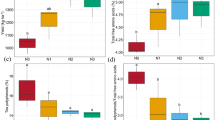Abstract
Monthly investigations of the microbial population associated with tea soils, in terms of colony-forming units assessed by the plate-count method, were carried out at three different soil depths for a period of 12 months. Three groups of microbes, bacteria, actinomycetes, and fungi, were examined. Contrary to general observations, the rhizosphere: soil ratios were found to be consistently below 1 in samples taken from established tea bushes, indicating an overall negative rhizosphere effect. Interactions among certain microorganisms may also have contributed to this effect. Nevertheless, the rhizosphere of young tea plants and that of a number of other perennial plants, of different ages, growing in established tea fields, appeared to stimulate microbial growth. The negative effect of the rhizosphere of older tea bushes does not appear to be a common phenomenon that is related to the aging of plants in general, but seems to be unique and specific to tea plants.
Similar content being viewed by others
References
Baath E, Olsson S, Tunlid A (1988) Growth of bacteria in the rhizoplane and the rhizosphere of rape seedlings. FEMS Microbiol Ecol 53:355–360
Bowen GD, Rovira AD (1989) The rhizosphere. In: Anderson JM, Ingram JSI (eds) Tropical soil biology and fertility. A handbook of methods. CAB International, Aberystwyth, pp 101–112
Chanway CP, Holl FB (1993) Ecotypic specificity of spruce emergence-stimulating Pseudomonas putida. Forest Sci 39:520–527
Curl EA, Truelove B (1986) The rhizosphere. Springer Verlag, Berlin Heidelberg New York
Fitter AH, Hay RKM (1981) Environmental physiology of plants. Academic Press, New York
Hiltner L (1904) Über neuere Erfahrungen und Probleme auf dem Gebiet der Bodenbakteriologie unter besonderer Berücksichtigung der Gründungung und Brache. Arb Dtsch Landwirtsch Ges 98:59–78
Holl FB, Chanway CP (1992) Rhizosphere colonization and seedling growth promotion of lodgepole pine by Bacillus polymyxa. Can J Microbiol 38:303–308
Ivarson KC, Katznelson H (1960) Studies on the rhizosphere microflora of yellow birch seedlings. Plant and Soil 12:30–40
Johnson LF, Curl EA (1972) Methods for research on the ecology of soil-borne plant pathogens. Burgess, Minneapolis
Kanwar BS (1990) Himachal Pradesh agricultural handbook. H. P. Vishva Vidyalays, Palampur
Katznelson H (1946) The rhizosphere effect of mangels on certain groups of micro-organisms. Soil Sci 62:343–354
Katznelson H (1965) Nature and importance of the rhizosphere. In: Baker KF, Synder WC (eds) Ecology of soil-borne plant pathogens. Univ Calif Press, Berkley, pp 187–209
Krupa S, Fries N (1971) Studies on the ectomycorrhizae of pine: 1. Production of volatile organic compounds. Can J Bot 49: 1425–1431
Lynch JM (1987a) Microbial interactions in the rhizosphere. Soil Microorg 30:33–41
Lynch JM (1987b) Biological control within microbial communities of the rhizosphere. In: Fletcher M, Gray TRG (eds) Ecology of microbial communities. Cambridge University Press, Cambridge, pp 55–82
Rangaswami G, Vasantharajan VN (1962) Studies on the rhizosphere microflora of citrus trees. 1. Quantitative incidence of microorganisms in relation to root and shoot growth. Can J Microbiol 8:473–477
Rouatt JW, Katznelson H (1961) A study of the rhizosphere soil of crop plants. J Appl Bacteriol 24:164–171
Rovira AD (1965) Interactions between plant roots and soil micro-organisms. Annu Rev Microbiol 19:241–266
Rovira AD (1991) Rhizosphere research—85 years of progress and frustration: In: Keister DL, Cregan PB (eds) The rhizosphere and plant growth. Kluwer Academic Publishers, Netherlands, pp 3–13
Snedecor GW, Cochran WG (1967) Statistical methods. Oxford and IBH Publishing Co, New Delhi
Starkey RL (1958) Inter-relations between microorganisms and plant roots in the rhizosphere. Bacteriol Rev 22:154–72
Sullia SB (1973) Effect of root exudates and extracts on rhizosphere fungi. Plant and Soil 39:197–200
Tang CS, Wat CK, Towers GHN (1987) Thiophenes and benzofurans in the undisturbed rhizosphere of Tagetes patula L. Plant and Soil 98:93–97
Walkley A, Black CA (1934) An examination of the Degtjareff method for determining soil organic matter and a proposed chromic acid titration method. Soil Sci 37:29–38
Author information
Authors and Affiliations
Rights and permissions
About this article
Cite this article
Pandey, A., Palni, L.M.S. The rhizosphere effect of tea on soil microbes in a Himalayan monsoonal location. Biol Fertil Soils 21, 131–137 (1996). https://doi.org/10.1007/BF00335924
Received:
Issue Date:
DOI: https://doi.org/10.1007/BF00335924




